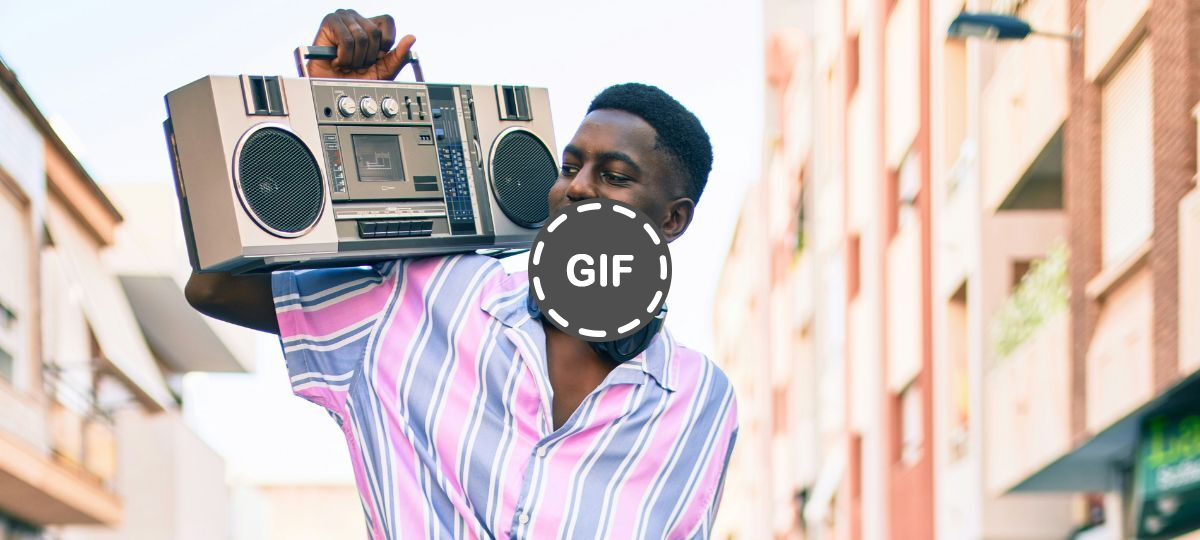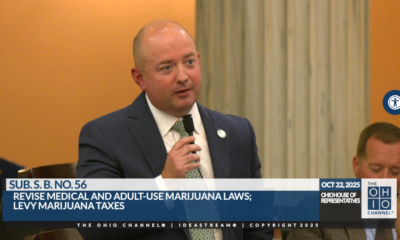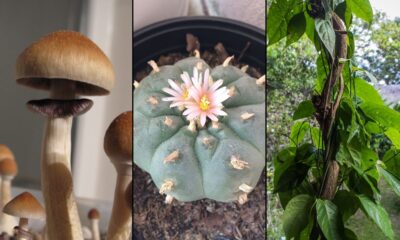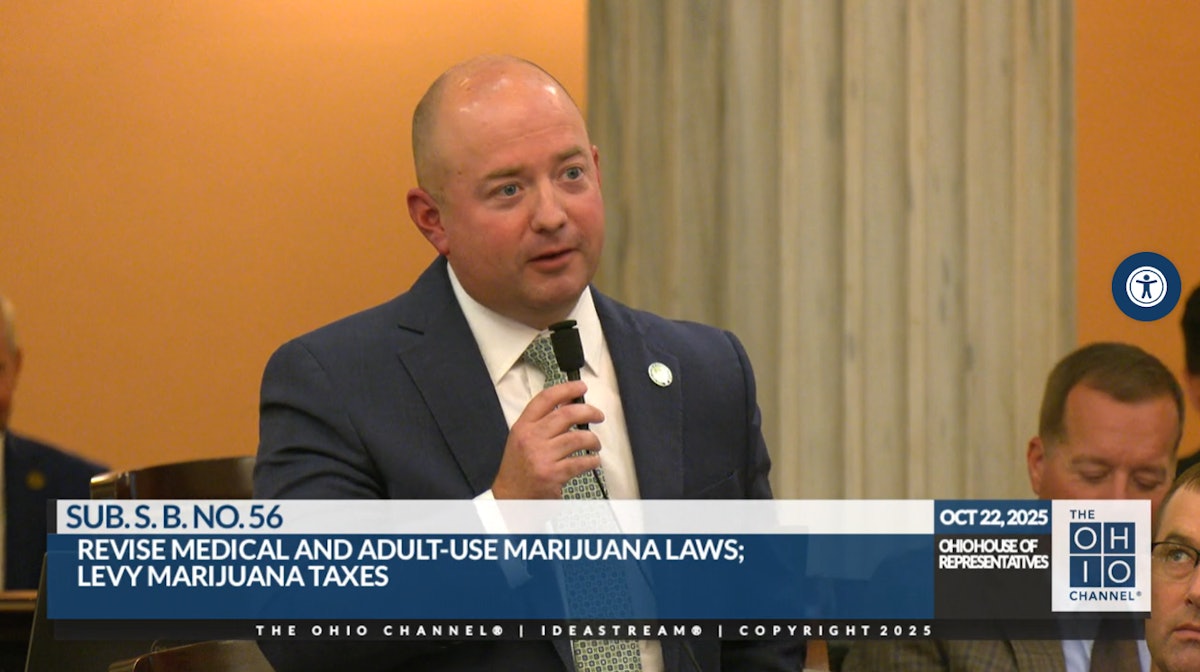featured
Kenya’s Music & Art Scene Keep Cannabis Culture Thriving Despite Colonial Laws
Published
6 days agoon

I’m in a bus on the Thika Super Highway, headed to Juja. It’s dark outside, but I leave my window open, loving how the wind feels against my face. My brother and I had a quick sesh before I left for home, and the THC is just now kicking in.
Gengetone music is blasting from the speakers, and as I nod my head along to the bassline, something my brother once said to me comes to mind.
“Why do artists feel the need to mention the fact that they smoke weed in every single song they write? Like, do they run out of subject matter, or what?”
I’m a musician who makes rap music, and I have mentioned weed in my songs from time to time, so I get a little defensive. I argue that it’s all about normalizing the use of cannabis.
When we spread awareness, we help people understand what cannabis is and what it isn’t, which goes a long way in reducing the stigma associated with it.
“Because otherwise, people look at us like we’re smokin’ crack!” I proclaim, passionately.
He’s not convinced.
“I can live with that. My problem is that young, influential artists are making catchy songs about ‘how great weed is’ and ten-year-old kids are dancing and singing along to them.”
I concede, saying that I see how that can be an issue, pass the joint back to him, and change the subject.
But as I sit in this matatu, vibing to the music, his point is proven. Pretty much every song alludes to smoking weed or mentions it outright.
I look around me. A group of young campus kids, drunk as sailors, are having a great time, singing along to every lyric.
But besides them, and myself, everyone else is a middle-aged person clearly on their way home from work. For the most part, everyone’s either on their phone or looking out the window.
Unperturbed.
Just a few years ago, the mere mention of cannabis would have had heads turning. Today, weed is so deeply embedded in Kenyan culture that it’s become impossible to escape it.
More importantly, even those who do not understand it have slowly come to accept it.
“And that’s why,” I should have argued, “everyone’s making songs and films about weed. The culture inspired the art, and not the other way around.”
While he may feel otherwise, I believe it’s a feat to be celebrated that we’ve single-handedly reframed cannabis from a taboo ‘narcotic’ to a cultural symbol of resistance, wellness, pleasure, and creativity. Here’s some context to give you an idea of how much ground we’ve covered.

Colonial Hangover: The Legal Backdrop
Before the British arrived in Kenya to gift us various goodies, among them displacement, segregation, and canvas safari boots, we all smoked weed. Different communities had different names for the herb, and communal festivals where people got high on ‘bangi’ and local booze, played music, danced, and played-fought were commonplace.
In 1914, several years into their rule, the British colonial administration introduced the Opium Ordinance, outlawing cannabis and starting the long history of cannabis prohibition.
When we regained our independence in 1963, we inherited these laws, and like a chronic hereditary illness, we’ve been unable to shake them to date.
Instead, in 1994, the Parliament passed the Narcotic Drugs & Psychotropic Substances (Control) Act into law, further cementing the prohibition of cannabis. This Act stated that it was against the law to cultivate, traffic, or possess cannabis, and outlined the consequences.
However, this Act allowed for the medical and industrial use of cannabis if regulations were enacted. They never were.
Between 2000 and 2010, law enforcement officials made a series of seizures. They also disrupted cannabis farming operations in Mt. Kenya, Western Kenya, and Lake Victoria. However, cannabis remained widely used.
Between 2017 and 2019, the late Kibra MP, Ken Okoth, who was being treated for cancer, introduced the Marijuana Control Bill. His goal? The decriminalization and regulation of cannabis. This heightened discourse surrounding medical and industrial use of cannabis.
In 2022, Presidential aspirant George Wajackoyah waved the ‘Legalize It’ flag, championing the medical benefits and economic implications. At this point, the conversation went national.
In 2023, a High Court ruling found that the Government of Kenya had neglected its duties by failing to implement licensing regulations for medical and industrial cannabis use as provided for under the 1994 Act. The Court ordered that the government must be compliant within 24 months.
But while lawmakers stall, the culture continues to take root, and young artists are at the forefront of shifting the perception.
Gengetone & Arbantone: Soundtracks of Normalization
When Gengetone became a mainstream sensation, I was in my last year of high school. Our principal, God bless her heart, didn’t want us listening to any of it.
The lyrics were raunchy, raw, and rebellious, leaving nothing to the imagination. Neither did the videos, which for the most part depicted house parties, vivid cannabis imagery, and lots and lots of twerking.
I didn’t care much for the music at the time, finding it a little under-produced, especially at its onset. However, something was exciting about how risque it was, and youth all over the country gobbled it up, hook, line, and sinker.
Groups like Ethic, Ochungulo Family, and Boondocks Gang waxed poetic about marijuana in pretty much all their songs. Just Imagine Africa humorously suggested that “kama hupendi bangi we ni mtoto was shetani,” which translates to “if you don’t love weed you must be a child of the devil”.
Lil Maina’s first big single was a bop called Kishash, named after one of the many street names we have for cannabis. It’s a song about enjoying good weed at a bash with good friends. He raps:
“Depression ikikick in manze nitakiburn,” loosely translating to “When I feel depressed, a little weed goes a long way.”
This was one of the biggest tracks between 2022 and 2023, garnering close to 10 million streams on YouTube alone. Lil Maina may not write about cannabis so overtly anymore, but he drops slick references now and then.
When the hype around Gengetone died down, Arbantone was already crossing the threshold. This innovative genre samples local and international dancehall classics, adding a modern twist.
While this music is incredibly fun to party to, it does much more than set the soundtrack for a good time.
Just a year ago, we had an Arbantone protest anthem when we took to the streets to demonstrate against corruption, high taxation, and police brutality. Hundreds of thousands took to the streets with whistles, footballs, and Bluetooth speakers, and we danced to Anguka Nayo.
This anthem has become a part of pop culture, and everyone 50 years and younger knows it.
Cannabis in Hip-Hop
It’s almost expected for young people to make songs about weed, but it’s a whole other thing when older, more established hip-hop artists do it. Personally, I think it helps with the cause.
When Wakadinali released their album in 2023, I was immediately drawn to Mariwana. They sampled a Wajackoyah soundbite on the album, so I was prepared for what was to come.
The song itself is a beautiful love letter to cannabis, with the guys writing thoughtful verses about what cannabis means to them. They also detail their first encounter with the herb, making for a relatable and enjoyable listen.
It’s no surprise that that’s one of their fan favourites from that project. The innovative video for the song, featuring puppets, has garnered nearly 5 million views on YouTube.
Kenyan Hip-Hop icon Octopizzo did the same thing, releasing at least two cannabis-inspired joints in one album. One was King Size.
In One More Time, a reggae-rap vibe that’s perfect for a morning sesh, he instructs, “Asha ngwai, asha ngwai,” meaning “Light that weed.”
And years before that, he released Wakiritho with the Gengetone group Sailors. To me, he was passing the torch, or the joint, if you will, to the new generation. More importantly, however, was the message this sent to his own generation.
The reality is that cannabis in music normalizes use in everyday speech. It educates the world that people who enjoy weed exist, reduces the stigma, and ideally even makes non-smokers more tolerant.
Bensoul: Kenya’s Cannabis Brand Ambassador
Few Kenyan artists are as dedicated to the legalization cause as Bensoul. While many choose to keep their love for cannabis on the low, afraid it will tarnish their image and cost them millions in brand deals, Bensoul is not one to shy away.
On 4/20 in 2020, when we were all cooped up in our homes, he released an EP. On it was Peddi, a song named after the slang term for cannabis peddlers, or plugs.
This is a love song, though, and on it, he croons: If you’ve been looking for a love peddler, then I hope you’re ready.
It’s a cheeky play on a popular slang term that everyone relates to, which made the song an instant hit.
In the video, he’s at a serene location smoking. It’s the first time a mainstream artist smoked so brazenly on camera. This was the beginning of a long-standing tradition: dropping cannabis-themed music every year on 4/20.
The following year, he released Sweet Sensi, a beautifully-produced love letter to marijuana. On this Reggae smash, Bensoul sings of his love for cannabis like a poet yearning for his lover.
“And when I think about the special place I keep my lighter
I can’t wait to get home, and light it up
You don’t know how, you don’t know how, you don’t know how good that feels
And when I think about the special place I keep my sensi
I can’t wait to get home, and light it up
You don’t know how, you don’t know how, you don’t know how good that feels.”
Everything about this song works, from the drums to the bassline to the enchanting horns that transport you right to the beach. It makes you feel like reaching for another joint, and you should, ‘cause that’s what Bensoul would do.
His debut album, released in 2023, took on the politics of decriminalization in even more depth. In Legalization featuring Lavosti, Bensoul hopes that he will see a time when we’ll be able to indulge freely in cannabis. When young, enterprising Kenyans can participate in the cannabis industry without discrimination or criminalization. He urges us not to lose hope and to keep fighting the good fight.
“I dream of a day/ When I will find on the menu/ A strain of a Kenyan grade/ On Moi Avenue,” he sings.
Watching him perform these songs live, it’s hard not to be moved to tears. The audience knows every word, and they resonate deeply. Lighter flicks ring out so often it’s got to be a fire hazard. By the end of the night, the entire venue reeks of weed, and we walk away healed, satiated, and glass-eyed.
When cannabis becomes legal in Kenya, Bensoul will be the first person to celebrate. And we’ll be there, revelling in the music as we live the prophecy of his pen.
Fashion & Visual Art: A Growing Green Aesthetic
Walking around town, you see more cannabis branding now than ever before. Rather than keeping their love for weed a secret, people wear it boldly. Whether it’s on a bandana, bucket hat, graphic tee, or printed all over a pair of socks, the cannabis leaf is more ubiquitous than it’s ever been.
Chains with cannabis leaf pendants are also common, and while I don’t own, and likely wouldn’t wear one, I must admit they do look pretty cool. So do the beaded Rastafarian flag bracelets that always seem to catch my eye when I’m out and about.
Even graffiti artists incorporate the cannabis leaf in their murals or depict cannabis use in some other way in their art. It’s almost as though everyone’s working together to spread the good Green Gospel, but the best part is it’s all happening organically.
Global Influences in the Local Context
Kenyans consume lots of American Hip-Hop and Jamaican roots-reggae music. In fact, one of my earliest memories is my mom bathing me while Fat Joe’s “Make It Rain” blasted from the neighbour’s boombox.
Step into a barbershop, khat den or matatu anywhere in the country, and chances are they’re playing Don Carlos, Israel Vibration, or Culture.
These two cultures have played a huge role in normalizing cannabis globally, including here in Kenya. We grew up watching rappers smoke Backwoods and our older cousins get caught in a trance listening to Bob Marley.
However, in rural areas where folks have no idea who Snoop Dogg and Wiz Khalifa are, local music has been the biggest influencer for cannabis normalization.
Today, cannabis culture is no longer imported; it’s rooted in Kenyan slang, music, and style, thriving in various youth subcultures across the country.
In Canada and the United States, the decriminalization, legalization, and normalization of cannabis came after its cultural normalization. Kenya is at a crucial tipping point, where culture leads while the law follows behind.
I’m confident it will catch up soon.
But for now…
The Stigma Erodes, & Perceptions Are Changing
When my mother found out I smoked weed a few years ago, she was mortified. She was scared for me, afraid that I’d spiral into psychosis, become unemployable, and become a thief to support my drug habit.
To her, my smoking weed wasn’t an informed choice; it was a moral failing.
I understood where she was coming from, but I made it clear that it would be almost impossible to have an objective conversation until she shifted her perspective.
Over the years, I’ve seen a huge change. Today, she coyly refers to it as ‘that pastime of yours’. Not habit. Pastime. That’s growth if you ask me.
In my opinion, the youth normalizing recreational cannabis use and being willing to have open conversations about it with their parents has significantly helped erode the stigma.
When we have nothing to hide, it proves that we have nothing to be ashamed of.
In Kenya, cannabis culture continues to thrive because we refuse to let outdated colonial laws stifle our creativity. Policy is bound to catch up eventually; in the meantime, we’ll continue using our music, fashion, and visual art to reshape how Kenyans see cannabis.
This article is from an external, unpaid contributor. It does not represent High Times’ reporting and has not been edited for content or accuracy.

Author: mscannabiz.com
MScannaBIZ for all you Mississippi Cannabis News and Information.
You may like
-


Ohio House Passes Cannabis, Hemp Bill Resulting From ‘Venn Diagram From Hell’
-


What To Know About Cannabis And A Brain Aneurysm
-


MariMed to Expand Brand Distribution to New York
-


Time for a Cannabis Reboot: Local Roots, Fair Markets, Real Change
-


Ohio Health Agency Grants $400,000 To Fund Psychedelics Education And Training For First Responders, Doctors And More
-


Curio Wellness Acquires 4 Greenlight Dispensaries in Missouri
featured
Ohio House Passes Cannabis, Hemp Bill Resulting From ‘Venn Diagram From Hell’
Published
52 minutes agoon
October 23, 2025
Ohio House lawmakers passed the 18th version of a bill on Oct. 22 that aims to alter the state’s adult-use cannabis laws that voters approved in 2023, while also creating a tightly defined regulatory framework for hemp products.
The 228-page legislation, Substitute Senate Bill 56, preserves many aspects of the voter-approved initiative, such as home grows (six per adult or 12 per household), sharing between adults 21 and older, and allocating 36% of cannabis excise tax revenues to local municipalities that host dispensaries.
However, the bill would prohibit public consumption at places like music concerts and bar patios, and those caught with cannabis purchased outside the state would be criminalized. No other state where cannabis is legal imposes such restrictions on out-of-state purchases, according to cannabis advocacy group NORML.
In addition, while adults could continue to home cultivate cannabis under the legislation, they’d be restricted to harvesting more than 2.5 ounces of flower, or roughly one plant, with a felony penalty for those who grow more than the number of plants allowed. Also, the bill intends to place a 35% THC cap on flower and a 70% THC cap on extracts for both medical and adult-use cannabis.
“This isn’t what Ohioans voted for, and the fact that this bill is being rushed through the Legislature, with almost no opportunity for public comment, indicates that lawmakers know they are undermining the will of the voters,” NORML Political Director Morgan Fox said in a public statement. “Regardless of where one stands on cannabis issues, everyone should be outraged at this.”
The substitute bill found bipartisan House support in an 87-8 vote on Oct. 22.
Rep. Brian Stewart, R-Ashville, who carried Sub. S.B. 56 in the House, said Wednesday on the chamber floor that the bill “preserves all of the core aspects” of what voters passed two years ago, including access to tested and regulated products from licensed dispensaries.
Stewart also argued that the Legislature has to act to preserve the 36% tax revenue fund for host communities after the Ohio Department of Taxation flagged language in the voter-approved initiative, suggesting that the language failed to properly appropriate the money.
“It was always going to require legislation in this chamber,” he said.
The substitute bill also intends to establish a legal pathway for licensed “hemp dispensaries” to sell regulated and tested intoxicating hemp products, defined as containing more than 0.5 milligrams of delta-9 THC per serving or 2 milligrams per package, or more than 0.5 milligrams of total non-delta-9 THC per package. These sales would be limited to those 21 and older. Those who sell intoxicating hemp products to those under 21 would be guilty of a misdemeanor on the first offense and a felony on a subsequent offense.
Meanwhile, cannabinoid hemp beverages would be defined and regulated differently with a $1.20-per-gallon excise tax (more on this later).
Stewart said provisions included in the 18th version of the substitute bill resulted from a “Venn diagram from hell” that attempted to balance individual liberties, consumer safety, the financial well-being of local communities, and the “need to protect the health and safety” of Ohio children.
“If you’re reading through it and you’re saying, ‘Rep. Stewart, I don’t like Section X, I don’t like Section Y,’ please know you’re in good company. I don’t either,” he said. “This is not the bill that I originally introduced. It’s not the bill that Representative [Tex] Fischer originally introduced. But it is a carefully crafted compromise that makes Ohio better.”
While the Senate passed its version of the legislation in February, cannabis advocacy groups like the Marijuana Policy Project applauded the House Judiciary Committee for sitting on the legislation for nearly eight months as a means to prevent recriminalization measures “pushed by the Senate.”
However, many House members said during this week’s floor debate that Gov. Mike DeWine’s executive order issued Oct. 8 – one that attempts to shut down hemp-derived cannabinoid product sales and initiate emergency rulemaking – spurred lawmakers to go back to the drawing board for a legislative fix.
DeWine showcased various intoxicating hemp products in packaging that mimicked popular candies, like Nerds, Sour Patch Kids and Gushers, during his Oct. 8 press conference.
After lawmakers were at an impasse, DeWine’s executive order represented a turning point on Sub. S.B. 56, Rep. Tex Fischer, R-Boardman, said before Wednesday’s floor vote.
“I think we all had an agreement that that was not the intent of the hemp legislation at the federal level or here in Ohio, but we did need to do something to protect kids from these products,” he said. “Some of these products are truly illicit and truly dangerous, and everybody, no matter how fervent of an activist on the hemp side of this issue you were, agreed something needed to be done.”
Legislative disagreements had revolved around Ohio businesses that would be negatively impacted by language in previous versions of the bill, Fischer said.
Under the House-passed substitute bill, places where children “walk freely,” like gas stations and grocery stores, would be prohibited from selling intoxicating hemp products, while certain intoxicating hemp retailers, such as a qualifying vape shop, would be “grandfathered in” for licensure.
For a retailer to qualify for a grandfathered-in hemp dispensary license, that retailer must have sold intoxicating hemp products on or before Aug. 30, and the store’s receipts from hemp and intoxicating hemp product sales must have exceeded 80% of its total gross receipts for either the past 12 months or the 2024 calendar year.
“What about those people that have poured their blood, sweat, tears, years of work, potentially millions of dollars into building a business living by the rules that we set out, whether they were adequate or not, they were not breaking the law,” Fischer said. “Those were the people that I was motivated to stand up for, and while this bill doesn’t do everything that I wanted or everything that others want, I believe we have arrived at a reasonable conclusion to allow those people to still stay in business, to grandfather them into this new regulatory regime.”
No one under the age of 21 would be allowed inside these hemp dispensaries, which would be prohibited from selling cigarettes, tobacco, and vape or electronic smoking products under the bill. No more than 400 hemp dispensaries would be allowed in the state, unless those grandfathered in exceed that number.
While the biennial license renewal fee for Ohio’s cannabis dispensaries is $70,000, the two-year renewal license fee for a grandfathered-in hemp dispensary would be $35,000 under Sub. S.B. 56.
Meanwhile, hemp beverages, which the substitute bill defines as “drinkable cannabinoid products,” would be regulated differently. In addition, these products would be classified as low-level DCPs (5 milligrams or less of total THC per serving) or high-level DCPs (5-10 milligrams of total THC per serving). Only one serving per container would be allowed.
Neither low-level nor high-level DCPs would constitute an “intoxicating hemp product,” with DCPs falling under a separate regulatory framework for manufacturers, distributors and retailers. Still, sales to those under 21 would be prohibited.
Ohio retailers with Class C liquor licenses, such as grocery stores that sell alcohol for carryout only, would be allowed to sell high-level DCPs. Meanwhile, Ohio retailers with licenses for on-site consumption, such as restaurants and bars, would be allowed to sell low-level DCPs.
While the substitute bill would allow DCP manufacturers to create higher-dose beverages that contain more than 10 milligrams of THC, they would be restricted to distributing and/or selling those products to out-of-state partners.
Fischer said there were a lot of wins “for us so-called ‘hemp-resentatives,’” in the substitute bill.
“Many of you heard from beverage manufacturers, bars, restaurants, retailers about how popular these products are, but there are also a lot of folks that weren’t yet comfortable stocking these products because of the regulatory uncertainty that is a result of our inability to previously come to an agreement here in Columbus,” he said. “I think this strikes the appropriate tone of a reasonable, fair and pro-business regulatory regime while still maintaining that these products and consumers should be safe.”
While it’s unclear if the Senate will agree to the House’s amended substitute bill or take the legislation to a conference committee for further debate – before possibly sending the bill to DeWine’s desk – the potential outcomes are significant for Ohio stakeholders: cannabis businesses, hemp businesses, consumers, patients and children.
Rep. Jamie Callender, R-Concord, a long-time advocate for cannabis reform in the Buckeye State, acknowledged the legislation “is not perfect” before voting to support the bill.
Callender said a “no” vote on the legislation represents allowing retailers to continue selling high-THC products to children walking home from schools with impunity.
“I imagine everybody in this room can find at least one thing they don’t like in the bill, one thing they think can be improved on,” he said. “You have my commitment. I’ll keep working with everyone to make it better, but I believe we have to act.”

Author: mscannabiz.com
MScannaBIZ for all you Mississippi Cannabis News and Information.

Discover what to know about cannabis and a brain aneurysm—risks, recovery, and medical cautions.
When celebrity Kim Kardashian recently revealed she was diagnosed with a small brain aneurysm—reportedly detected during a routine MRI and attributed by her doctors to stress—her disclosure sparked interest in a condition most people don’t know much about. A brain aneurysm is a bulging or ballooning blood vessel in the brain, which can be life-threatening if it ruptures. With growing interest around cannabis use—both medically and recreationally—it’s worth exploring what to know about cannabis and a brain aneurysm.
RELATED: The Science Behind Cannabis And Happiness
A brain aneurysm (sometimes called an intracranial aneurysm) occurs when a weakened area of a blood vessel in the brain bulges outward. If the aneurysm ruptures, it can lead to a major bleed called a subarachnoid hemorrhage—a medical emergency. Many aneurysms remain small and never rupture, but risk factors include high blood pressure, smoking, genetic predisposition, and possibly vascular stress. Kim Kardashian’s case underlines how even individuals with public profiles and access to healthcare can face this silent risk.

Cannabis—or more precisely its components such as cannabidiol (CBD) and tetrahydrocannabinol (THC)—has been studied for a variety of health issues. For some conditions like chronic pain, certain forms of epilepsy, or spasticity in multiple sclerosis, cannabinoids may offer symptomatic relief. There is emerging evidence medical marijuana can improve quality of life for some patients: reducing pain, improving sleep or mood, and even decreasing reliance on opioids in certain contexts.
In the broad sense, in jurisdictions across the U.S., many patients use it under medical supervision for conditions like migraine, nausea from chemotherapy, or chronic neuropathic pain. “Medical” use does not equate to “safe in all contexts”—especially when other serious medical issues are present.
When it comes to brain aneurysms—particularly after diagnosis or treatment—the research raises caution flags about cannabis use:
- Studies show people who have had an aneurysmal subarachnoid hemorrhage (a burst aneurysm), cannabis users had higher rates of delayed cerebral ischemia (DCI)—a serious complication which can lead to poor outcome. One large study found cannabis users had about a 2.7 times greater risk of DCI compared with non-users.
- Other studies link recreational cannabis use to a higher likelihood of having an aneurysm rupture in the first place—one estimate suggested about an 18 % increased risk.
- Research also suggests cannabis affects vascular tone, cerebral blood flow, mitochondrial function in brain cells, and may contribute to vasospasm (narrowing of blood vessels) or oxidative stress—mechanisms which are particularly concerning in someone with a vulnerable blood vessel wall.
- One review warned even for unruptured aneurysms, if cannabis is used, individuals should be aware they may face worse outcomes should rupture occur.
RELATED: Evidence About Burning Mouth Syndrome And Cannabinoids
If you or someone you know has been diagnosed with a brain aneurysm (ruptured or unruptured), here are some practical steps:
- Talk to your neurologist/neurosurgeon about cannabis use. The research suggests elevated risks in people with aneurysms who use cannabis.
- Avoid assuming “medical use = safe.” Even if you’re using cannabis under a physician’s care, an aneurysm changes the risk profile.
- Focus on established risk-reduction: control blood pressure, stop smoking, manage cholesterol, avoid stimulants. These traditional strategies remain foundational.
- If you have an untreated aneurysm and are considering cannabis for medical reasons, proceed with caution.Ask your medical team about the specific size, location, treatment plan of your aneurysm and whether there are recommended restrictions.
- After an aneurysm rupture or treatment, strongly consider abstaining or closely monitoring any cannabis use. The data indicate increased complication rates in this particular setting.
The public disclosure by Kim Kardashian highlights how common aneurysms may be, but it also reminds us the decision to use cannabis in a medical context should be made carefully. While cannabis offers genuine medical benefits for some conditions, when a brain aneurysm is in the picture—especially one which has ruptured or is being observed—caution is warranted. Speak with a neurologist familiar with cerebrovascular risk, weigh the benefits and the unique risks, and make an informed choice rather than assuming “legal = safe.”

Author: mscannabiz.com
MScannaBIZ for all you Mississippi Cannabis News and Information.

[PRESS RELEASE] – NORWOOD, Mass., Oct. 23, 2025 – MariMed Inc., a leading cannabis consumer packaged goods company and retailer, announced a licensing agreement with Farm 2 Hand LLC, a New York State cannabis license holder, that will introduce the company’s top-selling portfolio of products throughout New York State. Terms of the agreement were not disclosed.
Farm 2 Hand intends to manufacture and distribute a variety of MariMed’s edible products as permitted under New York regulations. Those are initially expected to include Betty’s Eddies fruit chews; Bubby’s Baked baked goods; and InHouse gummies. The products will be produced in a new kitchen that MariMed will design and equip for Farm 2 Hand at Farm 2 Hand’s Bronx production facility.
“Expanding the availability of our brands to the Empire State and its $6 billion total addressable market marks a significant step forward in our plan to own top-selling cannabis brands across the U.S.,” MariMed CEO Jon Levine said. “The addition of New York to our distribution footprint will help drive wholesale revenue, and being in the nation’s top media and influencer market will also help increase national awareness for our brands.”
The company expects its products will be available to New York’s 500-plus dispensaries in 2026, following the build-out of the kitchen and regulatory approval.

Author: mscannabiz.com
MScannaBIZ for all you Mississippi Cannabis News and Information.

Ohio House Passes Cannabis, Hemp Bill Resulting From ‘Venn Diagram From Hell’

What To Know About Cannabis And A Brain Aneurysm

MariMed to Expand Brand Distribution to New York

Time for a Cannabis Reboot: Local Roots, Fair Markets, Real Change

Ohio Health Agency Grants $400,000 To Fund Psychedelics Education And Training For First Responders, Doctors And More

Curio Wellness Acquires 4 Greenlight Dispensaries in Missouri

The best places to be high in Seattle

Colombia’s Bold Offer to Trump: Legal Weed Exports for Peace

Trump DOJ Asks Supreme Court For Delayed Schedule In Case On Marijuana Users’ Gun Rights

Whiskey Company Scales Back Operations, Citing ‘Consumer Shifts’ Toward Marijuana As Alcohol Alternative

Smart Cannabis: The AI Revolution No Operator Can Ignore

New Jersey Gubernatorial Candidates Need To Step Up For Cannabis Consumers (Op-Ed)

Millennials Are Spending Big on Luxury Travel

West Virginia Medical Marijuana Revenue Is Supposed To Support Drug Treatment Programs, But Sits Unspent As Officials Worry About Federal Prohibition

Frequent Marijuana Use Is Tied To Lower Risk Of Liver Disease From Alcohol, New Study Finds

Ohio bill to scale back cannabis legalization passed by House (Newsletter: October 23, 2025)

FDA Weighs Petition On ‘Significant Harm’ Of Marijuana Hair Testing Device’s Positive Results From Secondhand Smoke

Wisconsin Lawmakers Rally for Medical Cannabis Legalization in Committee Hearing

Massachusetts Campaign To Roll Back Marijuana Legalization Law Is ‘On Track’ To Make 2026 Ballot, Spokesperson Says

Village Farms Introduces Industry-First, One-Way Aroma Valve in Cannabis Packaging

Ohio House Passes Bill To Remove Voter-Approved Marijuana Legalization Protections And Restrict Hemp Market

Sorting Robotics Becomes Cannabis Manufacturing’s First True Systems Integrator

Wisconsin Senators Hold Hearing On GOP Leader’s New Medical Marijuana Legalization Bill

Tariffs And Visas Add To The Cannabis Industry’s Misery

Alert: Department of Cannabis Control updates data dashboards with full data for 2023

Connecticut Appoints The US’s First Cannabis Ombudsperson – Yes there is a pun in there and I’m Sure Erin Kirk Is Going To Hear It More Than Once!

5 best CBD creams of 2024 by Leafly

Recreational cannabis on ballot for third time in South Dakota

EU initiative begins bid to open access to psychedelic therapies
New Study Analyzes the Effects of THCV, CBD on Weight Loss

Free delta-9 gummies from Bay Smokes

5 best autoflower seed banks of 2024 by Leafly

Discover New York’s dankest cannabis brands [September 2024]

Press Release: CANNRA Calls for Farm Bill to Clarify Existing State Authority to Regulate Hemp Products

May 2024 Leafly HighLight: Pink Runtz strain

5 best THC drinks of 2024 by Leafly

Local medical cannabis dispensary reacts to MSDH pulling Rapid Analytics License – WLBT

6 best CBD gummies of 2024 by Leafly

Curaleaf Start Process Of Getting Their Claws Into The UK’s National Health System – With Former MP (Resigned Today 30/5/24) As The Front Man

Horn Lake denies cannabis dispensary request to allow sale of drug paraphernalia and Sunday sales | News

5 best delta-9 THC gummies of 2024 by Leafly

The Daily Hit: October 2, 2024

Mississippi city official pleads guilty to selling fake CBD products

Nevada CCB to Accept Applications for Cannabis Establishments in White Pine County – “Only one cultivation and one production license will be awarded in White Pine County”

5 best THCA flower of 2024 by Leafly

Weekly Update: Monday, May 13, 2024 including, New Guide for Renewals & May Board meeting application deadline

6 best hemp pre-rolls of 2024 by Leafly

PRESS RELEASE : Justice Department Submits Proposed Regulation to Reschedule Marijuana
Trending
-

 California Cannabis Updates1 year ago
California Cannabis Updates1 year agoAlert: Department of Cannabis Control updates data dashboards with full data for 2023
-

 Breaking News1 year ago
Breaking News1 year agoConnecticut Appoints The US’s First Cannabis Ombudsperson – Yes there is a pun in there and I’m Sure Erin Kirk Is Going To Hear It More Than Once!
-

 best list1 year ago
best list1 year ago5 best CBD creams of 2024 by Leafly
-

 Business1 year ago
Business1 year agoRecreational cannabis on ballot for third time in South Dakota
-

 Business1 year ago
Business1 year agoEU initiative begins bid to open access to psychedelic therapies
-

 cbd1 year ago
cbd1 year agoNew Study Analyzes the Effects of THCV, CBD on Weight Loss
-

 Bay Smokes1 year ago
Bay Smokes1 year agoFree delta-9 gummies from Bay Smokes
-

 autoflower seeds1 year ago
autoflower seeds1 year ago5 best autoflower seed banks of 2024 by Leafly


